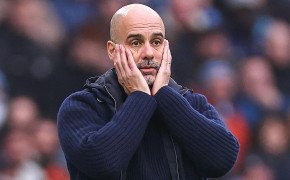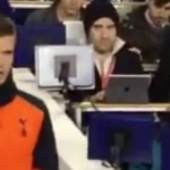Perhaps the only surprise of Spain’s 6-1 thrashing of Argentina was that so many people were surprised. A heavy defeat for the visitors in Madrid was always a possibility. For some time now, Argentina’s defensive resources have left a lot to be desired.
The key date is probably 2007, when Roberto Ayala retired from international football. He was the country’s last undoubtedly top class centre-back, and ever since he left the scene Argentina have struggled to form a coherent, balanced team. The point is re-enforced by a study of subsequent World Cups.
After a troubled campaign, Diego Maradona dragged Argentina over the line, winning a place in South Africa 2010 in the final qualifying round. His team was ultra-defensive. Some of the local media spoke of a Maradona influenced by the catenaccio tactics of 1980s Italian football.
But once the team had got to South Africa, Maradona could not control himself. He became caught up in his own rhetoric about inventing a bold new approach to the game.He felt obliged to find space in the starting line up for Carlos Tevez, and he ended up unbalancing his side and leaving the defence dangerously exposed. Germany ran amok in the quarter-final, easing to a 4-0 victory.
The next World Cup shows precisely the opposite dynamic. In qualification Argentina had Lionel Messi, Sergio Aguero, Angel Di Maria and Gonzalo Higuain all firing together. It was exhilarating to watch. But it did leave the team open. Coach Alejandro Sabella summed it up; there were times when his team were under attack when all he could do was close his eyes and pray. Nevertheless, he felt that running such risks was worthwhile; in a tit-for-tat open game, Argentina’s stars would tip the balance.
But then came the tournament. The World Cup, of course, is held at the end of the European season. Sabella quickly understood that his stars were suffering from burnout. They were no longer capable of taking on so much responsibility. The mathematics of the equation had changed. Argentina could no longer afford to leave their defence so unprotected. Sabella improvised a far more cautious game plan, and Argentina fought their way through to the final with a succession of backs-to-the-wall performances, mixing deep defence with occasional flashes of attacking brilliance. The four knockout games they were involved in (against Switzerland, Belgium, Holland and Germany) produced a grand total of three goals.
These tales of the last two World Cups illustrate a basic truth about the game. Defending is the easy part. Drop the defence deep, so they are covering reduced space. Have two banks of four close together. Stop the crosses at source. Be close enough together to create numerical superiority and to pick up the second balls. No one dives in, either committing himself and opening up a hole, or being suckered into giving away a rash free kick in a dangerous area. A team that follows these guidelines has a good chance of frustrating its opponent, even with a group of defenders who are some way short of world-class.
Win cash prizes for free with our competition!
| User |
Total tips |
Profit | 1 | Yield | Expected prize |
 Gambler420
Gambler420
|
115
|
376659 | 2 |
+14.93%
|
500 EUR |
 Betting_machine
Betting_machine
|
99
|
315482 | 3 |
+20.45%
|
250 EUR |
|
|
59
|
169873 | 4 |
+17.39%
|
125 EUR |
|
|
40
|
147780 | 5 |
+33.78%
|
75 EUR |
 LuckyZara
LuckyZara
|
145
|
25303 | 6 |
+3.72%
|
50 EUR |
Don't miss out - join our March Tipster Competition today
Defending, then, is relatively easy. The hard part is linking it to possession of the ball and creating chances. But a team that sets out to defend can often do it – so long as defending is the priority.
The problem facing current Argentina coach Jorge Sampaoli is that defending has never been a priority. His idea is to defend by attacking – by strangling the opposition in their half of the field, stopping the counter-attack at source, winning the ball high, enjoying the majority of possession and looking to create two against one situations close to the opposing goal.
When it works it can be overwhelming. But it is a high risk approach. If the opposition are able to manoeuvre the ball past the early lines of the press, the team has left so much vulnerable space behind its defensive line. And if that backline lacks pace, it will drop off and leave a gaping hole in midfield.
The alarm bells should have been ringing as soon as Sampaoli took the Argentina job in the middle of last year. His model of play is fixed. Did he have the defensive resources with Argentina to be able to carry it out? So far, the answer has been a resounding negative. There is a lack of defensive pace, of top-class keepers, of pedigree full-backs. He has tried with a back three – which collapsed in spectacular style against Nigeria last November. And his back four, with two out-of-their-depth full-backs collapsed alarmingly against Spain. So what now?
Sampaoli is a good enough coach to improve his team with time on the training ground. He did not want to play Italy or Spain in the recent FIFA dates, and he certainly does not want to go to Israel in early June for another warm-up game. As far as he is concerned, the time would be much better spent drilling and re-drilling his players in training. He will have the chance to improve matters. But the question is this – what does he want?
Does he really think that his customary model of play is viable? If not, will he try something more cautious? Is he capable of doing such a thing, not only technically but also psychologically? Producing a standard, dull, defensive team would seem to be against everything he stands for. But it might be the best solution.















